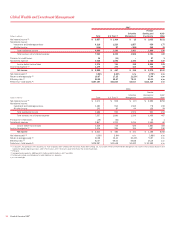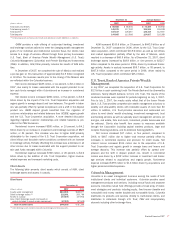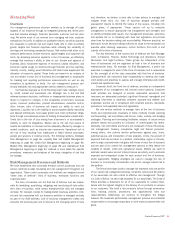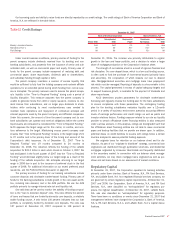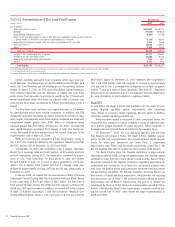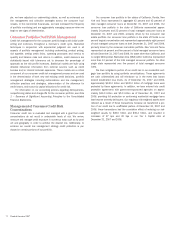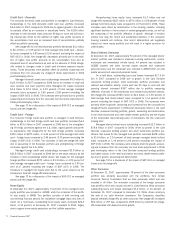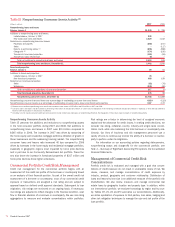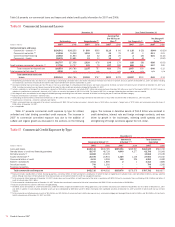Bank of America 2007 Annual Report Download - page 68
Download and view the complete annual report
Please find page 68 of the 2007 Bank of America annual report below. You can navigate through the pages in the report by either clicking on the pages listed below, or by using the keyword search tool below to find specific information within the annual report.Oversight
The Board oversees the risk management of the Corporation through its
committees, management committees and the Chief Executive Officer. The
Board’s Audit Committee monitors (1) the effectiveness of our internal
controls, (2) the integrity of our Consolidated Financial Statements and
(3) compliance with legal and regulatory requirements. In addition, the
Audit Committee oversees the internal audit function and the independent
registered public accountant. The Board’s Asset Quality Committee over-
sees credit risks and related topics that may impact our assets and earn-
ings. The Finance Committee, a management committee, oversees the
development and performance of the policies and strategies for managing
the strategic, credit, market, and operational risks to our earnings and
capital. The Asset Liability Committee (ALCO), a subcommittee of the
Finance Committee, oversees our policies and processes designed to
assure sound market risk and balance sheet management. The Global
Markets Risk Committee (GRC) has been designated by ALCO as the
primary governance authority for Global Markets Risk Management. The
Compliance and Operational Risk Committee, a subcommittee of the
Finance Committee, oversees our policies and processes designed to
assure sound operational and compliance risk management. The Credit
Risk Committee (CRC), a subcommittee of the Finance Committee, over-
sees and approves our adherence to sound credit risk management poli-
cies and practices. Certain CRC approvals are subject to the oversight of
the Board’s Asset Quality Committee. The Executive Management Team
(i.e., Chief Executive Officer and select executives of the management
team) reviews our corporate strategies and objectives, evaluates business
performance, and reviews business plans including economic capital allo-
cations to the Corporation and lines of business. Management continues
to direct corporate-wide efforts to address the Basel Committee on Bank-
ing Supervision’s new risk-based capital standards (Basel II). The Audit
Committee and Finance Committee oversee management’s plans to com-
ply with Basel II. For additional information, see the Basel II discussion on
page 68 and Note 15 – Regulatory Requirements and Restrictions to the
Consolidated Financial Statements.
Strategic Risk Management
Strategic risk is the risk that adverse business decisions, ineffective or
inappropriate business plans, or failure to respond to changes in the
competitive environment, business cycles, customer preferences, product
obsolescence, execution and/or other intrinsic risks of business will
impact our ability to meet our objectives. We use an integrated planning
process to help manage strategic risk. A key component of the planning
process aligns strategies, goals, tactics and resources throughout the
enterprise. The process begins with the creation of a corporate-wide busi-
ness plan which incorporates an assessment of the strategic risks. This
business plan establishes the corporate strategic direction. The planning
process then cascades through the lines of business, creating business
line plans that are aligned with the Corporation’s strategic direction. At
each level, tactics and metrics are identified to measure success in
achieving goals and assure adherence to the plans. As part of this proc-
ess, the lines of business continuously evaluate the impact of changing
market and business conditions, and the overall risk in meeting
objectives. See the Operational Risk Management section beginning on
page 93 for a further description of this process. Corporate Audit in turn
monitors, and independently reviews and evaluates, the plans and meas-
urement processes.
One of the key tools we use to manage strategic risk is economic
capital allocation. Through the economic capital allocation process, we
effectively manage each line of business’s ability to take on risk. Review
and approval of business plans incorporate approval of economic capital
allocation, and economic capital usage is monitored through financial and
risk reporting. Economic capital allocation plans for the lines of business
are incorporated into the Corporation’s operating plan that is approved by
the Board on an annual basis.
Liquidity Risk and Capital Management
Liquidity Risk
Liquidity is the ongoing ability to accommodate liability maturities and
deposit withdrawals, fund asset growth and business operations, and
meet contractual obligations through unconstrained access to funding at
reasonable market rates. Liquidity management involves forecasting fund-
ing requirements and maintaining sufficient capacity to meet the needs
and accommodate fluctuations in asset and liability levels due to changes
in our business operations or unanticipated events. Sources of liquidity
include deposits and other customer-based funding, and wholesale
market-based funding.
We manage liquidity at two levels. The first is the liquidity of the
parent company, which is the holding company that owns the banking and
nonbanking subsidiaries. The second is the liquidity of the banking sub-
sidiaries. The management of liquidity at both levels is essential because
the parent company and banking subsidiaries have different funding needs
and sources, and are subject to certain regulatory guidelines and require-
ments. Through ALCO, the Finance Committee is responsible for establish-
ing our liquidity policy as well as approving operating and contingency
procedures, and monitoring liquidity on an ongoing basis. Corporate
Treasury is responsible for planning and executing our funding activities
and strategy.
In order to ensure adequate liquidity through the full range of poten-
tial operating environments and market conditions, we conduct our liquid-
ity management and business activities in a manner that will preserve and
enhance funding stability, flexibility and diversity. Key components of this
operating strategy include a strong focus on customer-based funding,
maintaining direct relationships with wholesale market funding providers,
and maintaining the ability to liquefy certain assets when, and if, require-
ments warrant.
We develop and maintain contingency funding plans for both the
parent company and bank liquidity positions. These plans evaluate our
liquidity position under various operating circumstances and allow us to
ensure that we would be able to operate through a period of stress when
access to normal sources of funding is constrained. The plans project
funding requirements during a potential period of stress, specify and quan-
tify sources of liquidity, outline actions and procedures for effectively
managing through the problem period, and define roles and
responsibilities. They are reviewed and approved annually by ALCO.
66
Bank of America 2007


